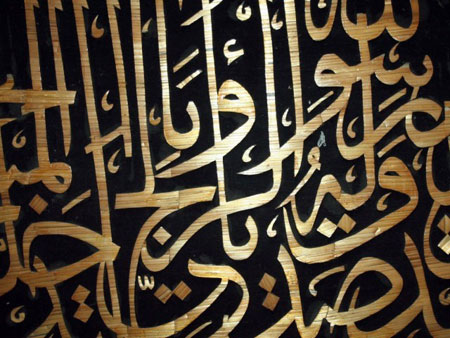Calligraphy: Living on a Prayer
Fifteen years ago calligrapher Azeem Iqbal’s mother had a dream: she saw that her son is in the Kingdom of Saudi Arabia, where he has been given the task of carving Quranic verses. In the dream, Iqbal’s mother provided him with leather, stone, metal etcetera to use as raw materials for his art. As dramatic as this may sound, the dream eventually became Iqbal’s goal and since then he has been striving hard to fulfill his mother’s dream by taking calligraphic art to a whole new level or rather taking it back to its original roots.
Born and raised in Mian Channu, Punjab, Iqbal’s love for art lay dormant in his early years and the unexplored artist within him tried to find solace by helping his father in their local wooden furniture business and even decided to take up pre-engineering in his youth. However, as time went by, his inclination towards art became apparent and he later realized that art was his true calling. It was his mother’s dream that finally led him to pick up various different materials and create a mural with them.
Iqbal started working with leather, wood, bones, stones, leaves, and metal; his aim was to use all those materials that were commonly used to compile verses of the Holy Quran during the Holy Prophet’s (pbuh) time. Iqbal also experimented with limestone, deer skin, engraved verses on metal and fashioned wood with the aim to create a collage that exudes divinity and transports the viewer to where it all began.
What sets Iqbal apart from all other calligraphers is his thirst to fuse different cultural aspects with religion and translate the melange on a blank canvas. The artist travelled to Iran to participate in one of the many majestic Ziarats (religious pilgrimage) Iran is famous for. On his return, Iqbal painted a collage and juxtaposed the Alam set (symbol of Hazrat Abbas’ hand and the flag which serves as the emblem of Shia sect) with Irani mosaic prints. Similarly, the calligrapher’s trip to Saudia Arabia reflects in his work; a collage made with gold leaf paper to denote the opulence of the Arab countries.
Just when one thinks that his creativity will stop here, Iqbal’s work reflecting Surah Al-Fatiha — painted with Aab-e-Zam Zam and embellished with stones retrieved from Ghar-e-Hira — proves you wrong.
After 15 years of assiduous work, Iqbal now proudly states that he has managed to gain international recognition as many of his fans come from different parts of the world to buy his painting. «There are about 700 of my works that are spread all over the world.»
The artist who has already received a Golden Jubilee Award as well as a gold medal from the Government of Punjab, is now being considered for the Pride of Performance award. Though such a title is generally considered for relatively more senior artists, Iqbal’s services in the field of religious art have proven that the calligrapher is an eligible candidate for this award.
Currently, his work is exhibited at the Rawalpindi Arts Council, where he also works as a professor, and his solo exhibition at the Gallery Louvre in Islamabad has had people coming in droves to appreciate the artist’s work. However, Iqbal, with his paint-soiled hands, remains calm and down-to-earth and tries to not let all this adulation get to his head. «I am just blessed to be working with the Prophet’s (pbuh) verses. I feel very lucky to be chosen for this work.»
Source: The Express Tribune




